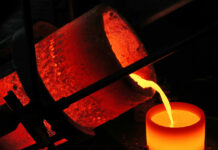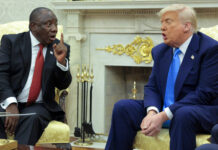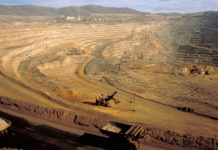
[miningmx.com] – THE minor mauling of the gold price in June had been largely reversed yesterday in New York suggesting that perhaps there’s wisdom in the consensus that the metal’s downside since its $220/oz mid-April drop is limited.
The view is supported by regular enough US economic data that reminds us the world’s largest economy is still not out of the woods: the contraction in the US manufacturing sector earlier this month, for instance. Quantitative easing will not be quelled soon either.
Assuming, perhaps boldly, that $1,400/oz is therefore a reasonable average gold price going forward, then at the current rand/dollar exchange rate – below 10 again – South African gold companies can expect a gold price received in the region of R445,000/kg. That’s only 4% to 5% less than the gold price received by most gold companies in South Africa during the December quarter.
That’s the powerful effect of the rand’s weakness. It would be folly for gold companies to plan on the highly liquid currency markets, but it sure does take the sting out of the last few months.
For instance, the weakness in the rand – by some 16% in the last 12 months – has helped pay for the 8% increase in electricity tariffs South African gold companies are expected to shoulder this year (excluding the winter tariff, only temporarily in place for several months, but which is also 8%).
Quite whether increased labour costs, which comprise more than 50% of gold mining cash costs, will be covered by rand weakness is the big unknown in charting the future investibility of gold shares.
It’s unlikely on the evidence of the National Union of Mineworkers (NUM’s) initial demands which ask for as much as 60% for entry-level workers which translates into a blended across-the-board increase in the high teens.
Even without assistance from the rand, there’s a growing view that gold companies may come back into vogue; at least, selected stocks of certain quality. The relief will be welcomed.
The South African gold index shed about 35% since the beginning of the year, and about 10% in the last month-and-a-half when the gold exposure specifically through exchange traded products was liquidated.
Since the onset of rand weakness, however, the gold index has gained about 7% with Harmony Gold, among others benefiting. According to SP Angel, a UK stockbroker, the shift from ETFs to equities ironically assists gold companies, especially those offering high yields among other qualities.
The view is supported by Macquarie Research in a note dated May 28. “In a relatively benign gold price environment (from here), and given the under-performance of the equities relative to the metal globally, we believe that there are four key reasons why gold equities (in this case South African majors) offer more upside than EFT: dividends, growth, valuation and leverage,’ it said.
According to the stockbroker, the best South African gold stock offering for dividend yield is Sibanye Gold whereas AngloGold Ashanti provides a growth and valuation investment case partly given the under-performance of its share price, and based on the fact the company intends adding 500,000 ounces in production, and possibly cutting the same amount of less profitable ounces.
AngloGold Ashanti is also considered one of the most defensive gold stocks of the South African suite given it has the lowest exposure to South Africa. Gold Fields, meanwhile, presents a growth and dividend play option although its success turns on making South Deep perform, while Harmony Gold is the leveraged play given its near complete exposure to South Africa, Macquarie Research said.
Rand weakness, however, brings with it problems. Imported consumables such as explosives or steel, petrol and diesel (to a limited amount) will all face heavy cost increases in about six months time. A downgrade by any of the ratings agencies also make it more expensive for South African gold companies to raise capital.
They aren’t alone, however.
The World Gold Council is considering introducing a new cost metric for the world’s gold miners called All-In-Sustaining Costs (AISC) which when extended by BMO Capital Markets to include tax and greenfields capital spend, sees only 5% of the world’s gold miners producing gold at costs that fall below the spot gold price (75% fall below the spot price of gold in the World Gold Council’s metric, however).
Both the World Gold Council and BMO Capital Markets don’t believe all gold companies reflect their costs accurately and that more fiscal discipline is required. Although BMO doesn’t identify any South African gold shares that would benefit from such discipline, it’s worth remarking that AngloGold Ashanti is 33% below its level a year ago whilst Harmony Gold is no less than 55% weaker.









